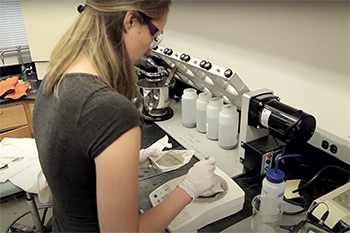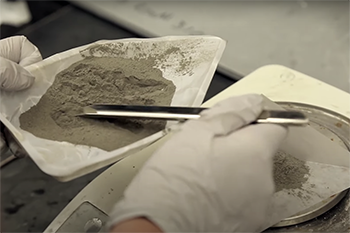
 |
| Turnipseed Family Chair and Professor Ching-Hua Huang, left, and Ph.D. candidate Laura Stoy, right, published research outlining a new method for extracting rare-earth elements from coal fly ash. |
By Melissa Fralick
Researchers from Georgia Tech’s School of Civil and Environmental Engineering have discovered a way to extract rare-earth elements—essential ingredients for nearly all modern electronics—from the ash left behind at coal-burning power plants using a non-toxic ionic liquid.
In a paper published in ACS’s Environmental Science and Technology on June 23, the Georgia Tech researchers showed that by applying an ionic liquid directly to solid coal fly ash, rare-earth elements can be successfully removed in a safe process that creates little waste. The study is co-led by Ching-Hua Huang, a professor of environmental engineering and Ph.D. candidate Laura Stoy. A third co-author, Victoria Diaz, is an undergraduate student who joined the lab as part of Georgia Tech’s Summer Undergraduate Research in Engineering/Sciences (S.U.R.E.) program.
Rare-earth elements (REEs) are a set of 17 elements that are utilized to make everything from permanent magnets in windmills to LED screens for computers and smart phones. While rare-earth elements aren’t as scarce as their name implies, only a few locations around the globe have deposits large enough to mine directly. Many of these reserves are in politically sensitive locations, resulting in global supply chain tensions.
“Right now, China produces over 80 percent of the world’s supply of rare-earth elements, meaning that if something were to happen to disrupt the global supply chain— like a ship getting stuck in the Suez Canal, or a pandemic, or a trade war with China—United States manufacturing might be cut off,” Stoy said. “Our work is one of many efforts to secure a domestic supply of rare earth elements and ensure affordable technology for everyday Americans.”
Finding New Sources
 Stoy working in the lab with coal fly ash |
Geopolitical tensions are exacerbating the scarcity of REEs, which are critical across many industries, such as renewable energy, national security and consumer technology. To ensure their supply, researchers are looking at alternative resources for REE recovery.
The U.S. Department of Energy is funding efforts to recover REEs from coal and coal combustion residuals. A promising source is coal fly ash, which is a byproduct from coal-fired power plants. This waste produced by burning coal for power can have concentrations of REEs similar to those found in raw ores.
Stoy said one of the exciting aspects of their research is finding a safe way to utilize the 130 million tons of coal fly ash that are produced in the United States every year. While some coal fly ash can be reused in concrete and construction products, most of it ends up sitting in landfills. Some of these landfills aren’t lined, making surrounding communities susceptible to dangerous elements like mercury, chromium, and lead that may leach out and contaminating nearby water supplies.
“Even if we stopped burning coal yesterday, we would still have tons of this material lying around, from decades of burning coal,” Stoy said. “Extracting REEs from these wastes represents one way to turn this trash into treasure and eliminate a risk at the same time.”
Ionic Liquids Could be the Key
Scientists know that coal fly ash contains high concentrations of REEs, but current methods of extracting these precious materials are hazardous and require several purification steps to obtain a usable product.
Huang and her research team have discovered a new method that utilizes an ionic liquid that is reusable and environmentally benign. Ionic liquids have only gained traction for use in metallurgy over the last decade, and this research represents the first time that ionic liquids have been directly applied to solid coal ash.
“This methodology is a significant paradigm shift away from the digestion of coal ash by strong acids or bases typical in other REE recovery methods,” Huang said. “This new approach is safer industrially, and is more environmentally sustainable with the recyclability of the ionic liquid.”
The ionic liquid the researchers used, betainium bis(trifluoromethylsulfonyl)imide or [Hbet][Tf2N], selectively dissolves rare-earth oxides over other metal oxides. This ionic liquid is also unique because it dissolves into water when heated and then separates into two phases when cooled.
The researchers tested this ionic liquid on two types of coal fly ash. Class F ashes have a minimum of 70 percent by mass of primary oxides such as silicon oxides, aluminum, and iron oxides. Class C ashes contain less of these oxides, but also tend to have more calcium.
 Coal fly ash |
The researchers pretreated Class F coal fly ash with an alkaline solution and dried it, a step not needed for less recalcitrant Class C fly ash. Then, they heated ash suspended in water with [Hbet][Tf2N], creating a single liquid phase. When cooled, the solutions separated. The ionic liquid extracted more than 77 percent of the rare-earth elements from freshly produced ash, and 97 percent from weathered ash that had spent years in a storage pond.
Finally, REEs were stripped from the ionic liquid with dilute acid. The researchers found that adding betaine during the leaching step increased the amounts of rare-earth elements extracted. The team tested the ionic liquid’s reusability by rinsing it with cold water to remove excess acid, finding no change in its extraction efficiency through three leaching-stripping-cleaning cycles.
The researchers say that this low-waste approach produces solution rich REEs, with limited impurities, and could be used to recycle precious materials from the abundance of coal fly ash held in storage ponds.
“By utilizing the unique properties of ionic liquids, our work demonstrates a novel approach in applying a recyclable ionic liquid to solid coal ash for REE recovery,” Huang said. “Our study demonstrates the success of this approach at the bench scale which can preferentially extract REEs from coal ash and separate them from most other metals under mild conditions.”
The research team is currently conducting studies to further optimize this process, including enhancing process efficiency, minimizing co-extraction of unwanted metals, and evaluating additional ionic liquids. They are also interested in assessing the potential to use the remaining coal ash solids, as well as purification of individual REEs. All of these works will facilitate the move to scale up this process in pilot testing.
Huang and team hope that their work will open the door to new research into the use of ionic liquids for coal fly ash. There are estimated to be billions of different ionic liquids—and their initial research focused on just one.
CITATION: Stoy, et.al., “Preferential Recovery of Rare-Earth Elements from Coal Fly Ash Using a Recyclable Ionic Liquid.” (Environmental Science & Technology) DOI: 10.1021/acs.est.1c00630
This work was supported by the National Science Foundation Graduate Research Fellowship, the Georgia Power Fellowship hosted by the Georgia Institute of Technology and the Environmental Research & Education Foundation. Any opinions, findings, and conclusions or recommendations expressed in this material are those of the authors and do not necessarily reflect the view of the sponsoring agency.
Related:
- Preferential Recovery of Rare-Earth Elements from Coal Fly Ash Using a Recyclable Ionic Liquid
- 30 Second Thesis: Laura Mast and Rare Earth Elements
- Ching-Hua Huang
